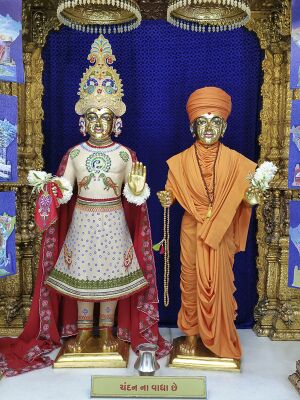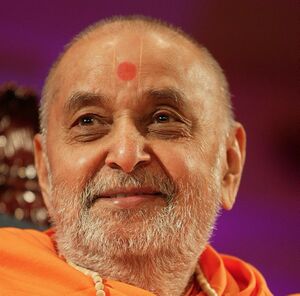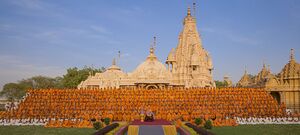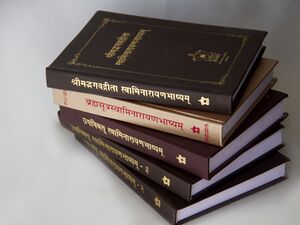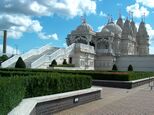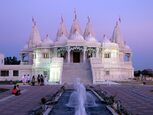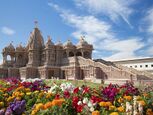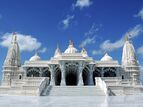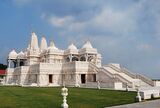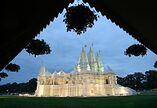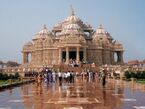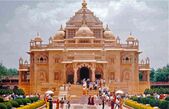بوتشاسانواسي أكشار بوروشوتام سوامينارايان سانستا
| ملف:Baps logo.svg BAPS Akshar Deri Logo | |
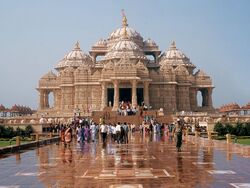 | |
| الاختصار | BAPS |
|---|---|
| التشكل | 5 يونيو 1907 |
| المؤسس | Shastriji Maharaj |
| النوع | Religious organisation |
| المقر الرئيسي | Ahmedabad, Gujarat, India |
| الموقع |
|
منطقة الخدمة | Worldwide |
| القائد | Mahant Swami Maharaj |
| الموقع الإلكتروني | www www |
Bochasanwasi Akshar Purushottam Swaminarayan Sanstha (BAPS; IAST: Bocāsaṇvāsī Akṣar Puruṣottam Svāminārāyaṇa Saṇsthā) is a Hindu denomination within the Swaminarayan Sampradaya.[1][2][3] It was formed in 1905 by Yagnapurushdas (Shastriji Maharaj) following his conviction that Swaminarayan remained present on earth through a lineage of gurus starting with Gunatitanand Swami.[4][5][6]
Since 1971, under the leadership of Pramukh Swami Maharaj, the BAPS has grown strongly. As of 2019, BAPS has 44 shikharbaddha mandirs and more than 1,200 mandirs worldwide that facilitate practice of this doctrine by allowing followers to offer devotion to the murtis of Swaminarayan, Gunatitanand Swami, and their successors.[7] BAPS mandirs also feature activities to foster culture and youth development. Many devotees view the mandir as a place for transmission of Hindu values and their incorporation into daily routines, family life, and careers.[8][web 1]
BAPS also engages in a host of humanitarian and charitable endeavors through BAPS Charities, a separate non-profit aid organisation which has spearheaded a number of projects around the world addressing healthcare, education, environmental causes, and community-building campaigns.[9]
As of 2022, BAPS is facing a lawsuit in United States courts, where plaintiffs allege starvation wages, cruel work conditions, visa fraud, and passport confiscation at several temple construction sites across the country.
. . . . . . . . . . . . . . . . . . . . . . . . . . . . . . . . . . . . . . . . . . . . . . . . . . . . . . . . . . . . . . . . . . . . . . . . . . . . . . . . . . . . . . . . . . . . . . . . . . . . . . . . . . . . . . . . . . . . . . . . . . . . . . . . . . . . . . . . . . . . . . . . . . . . . . . . . . . . . . . . . . . . . . . .
History
Formation and early years (1900-1950)
The Gunatit Guru
The basis for the formation of BAPS was Shastriji Maharaj's conviction that Swaminarayan remained present on earth through a lineage of Gunatit Gurus (perfect devotee), starting with Gunatitanand Swami, one of Swaminarayan's most prominent disciples,[4][10][11][12][5][13][note 1] and that Swaminarayan and his choicest devotee, Gunatitanand Swami, were ontologically, Purushottam and Akshar, respectively.[19][note 2] According to the BAPS-tradition, Shastriji Maharaj had understood this from his guru, Bhagatji Maharaj, who had Gunatitanand Swami as his guru.[23][note 3]
Followers of BAPS believe that the Ekantik dharma that Swaminarayan desired to establish is embodied and propagated by the Ekantik Satpurush ("a most sublime saint"[web 3][note 4]), the Gunatit Guru.[25] According to Shastriji Maharaj, Swaminarayan had "expressly designated" the Gunatit Guru to spiritually guide the satsang (spiritual fellowship) while instructing his nephews to help manage the administration of the fellowship within their respective dioceses.[10][26] As Kim notes, "For BAPS devotees, the dual murtis in the original Swaminarayan temples[note 5] imply that Swaminarayan did install a murti of himself alongside the murti of his ideal bhakta or Guru".[27]
Shastriji Maharaj sought to publicly reveal his ideas,[19] and to worship Gunatitanand as the abode of Purushottam, c.q. Swamiarayan.[6] However, his views were rejected by the sadhus of the Vadtal and Ahmedabad dioceses.[28][4][29][30] For the sadhus of the Vadtal diocese, the idea that Swaminarayan had appointed Gunatitanand as his spiritual successor, instead of the two acharyas, was a heretical teaching, and they "refused to worship what they considered to be a human being."[31][note 6] Shastriji Maharaj left Vadtal with five swamis and the support of about 150 devotees.[36][37][38]
Mandirs to facilitate doctrinal practice
Paralleling Sahajand Swami's building of temples to propagate his teachings,[27][note 5] Shastriji Maharaj then set out to build his own mandir to "house the devotional representations of Bhagwan and Guru" and propagate his understanding of Swaminarayan's teachings.[12] On 5 June 1907, Shastriji Maharaj consecrated the murtis of Swaminarayan and Gunatitanand Swami in the central shrine of the shikharbaddha mandir he was constructing in the village of Bochasan in the Kheda District of Gujarat.[40] This event was later seen to mark the formal establishment of the Bochasanwasi Akshar Purushottam Swaminarayan Sanstha,[27] which was later abbreviated as BAPS. The Gujarati word Bochasanwasi implies hailing from Bochasan, since the organisation's first mandir was built in this village.
Shastriji Maharaj spent the majority of 1908–15 discoursing throughout Gujarat, while continuing construction work of mandirs in Bochasan and Sarangpur, gaining a group of devotees, admirers, and supporters.[41] Over the next four decades, Shastriji Maharaj completed four more shikharbaddha mandirs in Gujarat (Sarangpur – 1916, Gondal – 1934, Atladra – 1945, and Gadhada – 1951).[41]
Successors
On 12 August 1910 Shastriji Maharaj met his eventual successor, Yogiji Maharaj, at the house of Jadavji in Bochasan.[38] Yogiji Maharaj was a resident swami at Junagadh Mandir (Saurashtra),[42] where Gunatitanand Swami had served as mahant.[38] Yogiji Maharaj regarded Gunatitanand Swami as Akshar and also served the murti of Harikrishna Maharaj which had previously been worshiped by Gunatitanand Swami.[38] As he already believed in the doctrine being preached by Shastriji Maharaj, Yogiji Maharaj left Junagadh on 9 July 1911 with six swamis to join Shastriji Maharaj's mission.[19]
On 7 November 1939, 17-year-old Shantilal Patel (who would become Pramukh Swami Maharaj) left his home[43] and was initiated by Shastriji Maharaj into the parshad order, as Shanti Bhagat, on 22 November 1939,[44] and into the swami order, as Narayanswarupdas Swami, on 10 January 1940.[44] Initially, he studied Sanskrit and Hindu scriptures[44] and served as Shastriji Maharaj's personal secretary. In 1946, he was appointed administrative head (Kothari) of the Sarangpur mandir.[44]
In the early part of 1950, Shastriji Maharaj wrote several letters to 28-year-old Shastri Narayanswarupdas expressing a wish to appoint him as the administrative president of the organisation. Initially, Shastri Narayanswarupdas was reluctant to accept the position, citing his young age and lack of experience and suggesting that an elderly, experienced swami should take the responsibility.[45] However, Shastriji Maharaj insisted over several months, until, seeing the wish and insistence of his guru, Shastri Narayanswarupdas accepted the responsibility.[44] On 21 May 1950 at Ambli-Vali Pol in Amdavad, Shastriji Maharaj appointed Shastri Narayanswarupdas as the administrative president (Pramukh) of BAPS.[38] He instructed Shastri Narayanswarupdas, who now began to be referred to as Pramukh Swami, to ennoble Satsang under the guidance of Yogiji Maharaj.[46]
In the last few years of his life, Shastriji Maharaj took steps to preserve the growth and future of BAPS by registering BAPS as a charitable trust in 1947 under India's new legal code.[38]
Development and organisational formation (1950–1971)
After the death of Shastriji Maharaj on 10 May 1951,[47] Yogiji Maharaj became the spiritual leader, or guru, of the organisation while Pramukh Swami continued to oversee administrative matters as president of the organisation.[48] Yogiji Maharaj carried Shastriji Maharaj's mission of fostering the Akshar-Purushottam Upasana doctrine by building temples, touring villages, preaching overseas and initiating weekly local religious assemblies for children, youths and elders. In his 20 years as guru, from 1951 to 1971, he visited over 4,000 cities, towns and villages, consecrated over 60 mandirs and wrote over 5,45,000 letters to devotees.[38]
Youth Movement
This period of BAPS history saw an important expansion in youth activities. Yogiji Maharaj believed that in a time of profound and rapid social ferment, there was an imminent need to save the young from 'degeneration of moral, cultural and religious values'.[49] To fill a void in spiritual activities for youths, Yogiji Maharaj started a regular Sunday gathering (Yuvak Mandal) of young men in Bombay[49] in 1952.[38] Brear notes, "His flair, dynamism and concern led within ten years to the establishment of many yuvak mandals of dedicated young men in Gujarat and East Africa".[49] In addition to providing religious and spiritual guidance, Yogiji Maharaj encouraged youths to work hard and excel in their studies. Towards realizing such ideals, he would often remind them to stay away from worldly temptations.[50] A number of youths decided to take monastic vows.[51] On 11 May 1961 during the Gadhada Kalash Mahotsav, he initiated 51 college-educated youths into the monastic order as swamis.[38] Mahant Swami Maharaj initiated as Keshavjivandas Swami was one of the initiates.
East Africa
Satsang in Africa had started during Shastriji Maharaj's lifetime, as many devotees had migrated to Africa for economic reasons. One of Shastriji Maharaj's senior swamis, Nirgundas Swami, engaged in lengthy correspondence with these devotees, answering their questions and inspiring them to start satsang assemblies in Africa. Eventually, in 1928, Harman Patel took the murtis of Akshar-Purushottam Maharaj to East Africa and started a small centre.[38] Soon, the East Africa Satsang Mandal was established under the leadership of Harman Patel and Magan Patel.[38]
In 1955, Yogiji Maharaj embarked on his first foreign tour to East Africa.[49][52] The prime reason for the visit was to consecrate Africa's first Akshar-Purushottam temple in Mombasa. The temple was inaugurated on 25 April 1955.[38][53] He also travelled to Nairobi, Nakuru, Kisumu, Tororo, Jinja, Kampala, Mwanza and Dar es salaam.[38] His travels inspired the local devotees to begin temple construction projects. Due to the visit, in a span of five years, the devotees in Uganda completed the construction of temples in Tororo, Jinja and Kampala and asked Yogiji Maharaj to revisit Uganda to install the murtis of Akshar-Purushottam Maharaj. The rapid temple constructions in Africa were helped by the presence of early immigrants, mainly Leva Patels, who came to work as masons, and were particularly skilled in temple building.[54]
As a result, Yogiji Maharaj made a second visit to East Africa in 1960 and consecrated hari mandirs in Kampala, Jinja and Tororo in Uganda.[38] Despite his failing health, Yogiji Maharaj at the age of 78 undertook a third overseas tour of London and East Africa in 1970.[38] Prior to his visit, the devotees had purchased the premises of the Indian Christian Union at Ngara, Kenya in 1966 and remodeled it to resemble a three-spired temple.[55] Yogiji Maharaj inaugurated the temple in Ngara, a suburb of Nairobi in 1970.[53][55]
. . . . . . . . . . . . . . . . . . . . . . . . . . . . . . . . . . . . . . . . . . . . . . . . . . . . . . . . . . . . . . . . . . . . . . . . . . . . . . . . . . . . . . . . . . . . . . . . . . . . . . . . . . . . . . . . . . . . . . . . . . . . . . . . . . . . . . . . . . . . . . . . . . . . . . . . . . . . . . . . . . . . . . . .
England
In 1950, disciples Mahendra Patel and Purushottam Patel held small personal services at their homes in England. Mahendra Patel, a barrister by vocation, writes, "I landed in London in 1950 for further studies. Purushottambhai Patel...was residing in the county of Kent. His address was given to me by Yogiji Maharaj".[56] Beginning 1953, D. D. Meghani held assemblies in his office that brought together several followers in an organized setting. In 1958, leading devotees including Navin Swaminarayan, Praful Patel and Chatranjan Patel from India and East Africa began arriving to the UK.[56] They started weekly assemblies at Seymour Place every Saturday evening at a devotee's house.[56] In 1959, a formal constitution was drafted and the group registered as the "Swaminarayan Hindu Mission, London Fellowship Centre".[56] D.D. Megani served as Chairman, Mahendra Patel as Vice-Chairman and Praful Patel the secretary.[56] On Sunday, 14 June 1970, the first BAPS temple in England was opened at Islington by Yogiji Maharaj.[56] In this same year he established the Shree Swaminarayan Mission[57] as a formal organisation.[58]
United States
Yogiji Maharaj was unable to travel to the United States during his consecutive foreign tours. Nonetheless, he asked Dr. K.C. Patel to begin satsang assemblies in the United States.[59] He gave Patel the names of 28 satsangi students to help conduct [satsang] assemblies.[59]
In 1970, Yogiji Maharaj accepted the request of these students and sent four swami to visit the U.S.[59][60] The tour motivated followers to start satsang sabhas in their own homes every Sunday around the country.[59] Soon, K.C. Patel established a non-profit organisation known as BSS under US law.[61] Thus, a fledgling satsang mandal formed in the United States before the death of Yogiji Maharaj in 1971.
Growth and further global expansion (1971–2016)
After Yogiji Maharaj's death, Pramukh Swami Maharaj became both the spiritual and administrative head of BAPS[62] in 1971.[63] He was the fifth spiritual guru of the BAPS organisation.[64] Under his leadership, BAPS has grown into a global Hindu organisation and has witnessed expansion in several areas. His work has been built on the foundations laid by his gurus – Shastriji Maharaj and Yogiji Maharaj.
Personal outreach (1971–1981)
Immediately upon taking helm, Pramukh Swami Maharaj ventured on a hectic spiritual tour in the first decade of his role as the new Spiritual Guru. Despite health conditions—cataract operation in 1980—he continued to make extensive tours to more than 4000 villages and towns, visiting over 67,000 homes and performing image installation ceremonies in 77 temples in this first decade.[65] He also embarked on a series of overseas tours beginning in 1974 as the guru. Subsequent tours were made in 1977, 1979, and 1980.[66]
Overall, he embarked on a total of 28 international spiritual tours between 1974 and 2014.[59][67] His travels were motivated by his desire to reach out to devotees for their spiritual uplift and to spread the teachings of Swaminarayan.[68]
Festivals and organisation (1981–1992)
The personal outreach (vicharan) of the earlier era (1971–1981) by Pramukh Swami Maharaj through traveling to villages and towns, writing letters to devotees, and giving discourses contributed to sustaining a global BAPS community.
The Gujarati migration patterns in the early 1970s, globalization factors and economic dynamics between India and the West saw the organisation transform into a transnational devotional movement.[69] organisational needs spanned from transmitting cultural identity through spiritual discourses to the newer much alienated generation in the new lands, temple upkeep and traveling to regional and local centres to disseminate spiritual knowledge. As a result, this era saw a significant rise in the number of swamis initiated to maintain the organisational needs of the community – both in India and abroad. Furthermore, having access to a greater volunteer force and community enabled the organisation to celebrate festivals on a massive scale which marked the arrival of a number of milestone anniversaries in the history of the organisation, including the bicentenary of Swaminarayan, bicentenary of Gunatitanand Swami, and the centenary of Yogiji Maharaj. Some effects of the celebration included a maturation of organisational capacity, increased commitment and skill of volunteers, and tangentially, an increased interest in the monastic path.
The Swaminarayan bicentenary celebration, a once in a life-time event for Swaminarayan followers, was held in Ahmedabad in April 1981.[[#cite_note-FOOTNOTEWilliams2001[[تصنيف:مقالات_بالمعرفة_بحاجة_لذكر_رقم_الصفحة_بالمصدر_from_June_2021]][[Category:Articles_with_invalid_date_parameter_in_template]]<sup_class="noprint_Inline-Template_"_style="white-space:nowrap;">[<i>[[المعرفة:Citing_sources|<span_title="هذه_المقولة_تحتاج_مرجع_إلى_صفحة_محددة_أو_نطاق_من_الصفحات_تظهر_فيه_المقولة'"`UNIQ--nowiki-00000098-QINU`"'_(June_2021)">صفحة مطلوبة</span>]]</i>]</sup>-81|[70]]] On 7 March 1981, 207 youths were initiated into the monastic order.[[#cite_note-FOOTNOTEWilliams2001[[تصنيف:مقالات_بالمعرفة_بحاجة_لذكر_رقم_الصفحة_بالمصدر_from_June_2021]][[Category:Articles_with_invalid_date_parameter_in_template]]<sup_class="noprint_Inline-Template_"_style="white-space:nowrap;">[<i>[[المعرفة:Citing_sources|<span_title="هذه_المقولة_تحتاج_مرجع_إلى_صفحة_محددة_أو_نطاق_من_الصفحات_تظهر_فيه_المقولة'"`UNIQ--nowiki-0000009A-QINU`"'_(June_2021)">صفحة مطلوبة</span>]]</i>]</sup>-82|[71]]] In 1985 the bicentenary birth of Gunatitanand Swami was celebrated.[[#cite_note-FOOTNOTEWilliams2001[[تصنيف:مقالات_بالمعرفة_بحاجة_لذكر_رقم_الصفحة_بالمصدر_from_June_2021]][[Category:Articles_with_invalid_date_parameter_in_template]]<sup_class="noprint_Inline-Template_"_style="white-space:nowrap;">[<i>[[المعرفة:Citing_sources|<span_title="هذه_المقولة_تحتاج_مرجع_إلى_صفحة_محددة_أو_نطاق_من_الصفحات_تظهر_فيه_المقولة'"`UNIQ--nowiki-0000009C-QINU`"'_(June_2021)">صفحة مطلوبة</span>]]</i>]</sup>-83|[72]]] During this festival, 200 youths were initiated into the monastic order.[73]
The organisation held Cultural Festivals of India in London in 1985 and New Jersey in 1991.[73] The month-long Cultural Festival of India was held at Alexandra Palace in London in 1985.[73] The same festival was shipped to US as a month-long Cultural Festival of India at Middlesex County College in Edison, New Jersey.[49]
Migrational patterns in the 70s led to a disproportionate number of Hindus in the diaspora.[69] Culturally, a need arose to celebrate special festivals (Cultural Festival of India) to reach out to youths in the diaspora to foster understanding and appreciation of their mother culture in a context accessible to them.[63][74] To engage the youths, festival grounds housed temporary exhibitions ranging from interactive media, dioramas, panoramic scenes and even 3D-exhibits.
By the end of the era, owing to the success of these festivals and the cultural impact it had on the youths, the organisation saw a need to create a permanent exhibition in the Swaminarayan Akshardham (Gandhinagar) temple in 1991.
In 1992, a month-long festival was held to both celebrate Yogiji Maharaj's centenary and to inaugurate a permanent exhibition and temple called Swaminarayan Akshardham (Gandhinagar). The festival also saw 125 youths initiated into the monastic order bringing the total number of swamis initiated to more than 700 in fulfillment to a prophecy made by Yogiji Maharaj.[75]
Mandirs and global growth (1992–2016)
In the third leg of the era, the organisation saw an unprecedented level of mandir construction activities taking place in order to accommodate the rapid rise of adherents across the global Indian diaspora. Initially, beginning with the inauguration of Swaminarayan Akshardham (Gandhinagar) in 1992. A number of shikharbaddha mandirs (large traditional stone mandirs) were inaugurated in major cities; Neasden (1995), Nairobi (1999), New Delhi (2004), Swaminarayan Akshardham (New Delhi) (2005), Houston (2004), Chicago (2004), Toronto (2007), Atlanta (2007), Los Angeles (2012), and Robbinsville (2014).
Mahant Swami Maharaj as Guru (2016 – present)
On 20 July 2012, in the presence of senior swamis in Ahmedabad, Pramukh Swami Maharaj revealed Keshavjivandas Swami (Mahant Swami) as his spiritual successor.[76]
Following the death of Pramukh Swami Maharaj on 13 August 2016, Mahant Swami Maharaj became the 6th guru and president of BAPS.[77] In 1961, he was ordained as a swami by Yogiji Maharaj and named Keshavjivandas Swami. Due to his appointment as the head (mahant) of the mandir in Mumbai, he became known as Mahant Swami.[78]
He continues the legacy of the Aksharbrahma Gurus by visiting BAPS mandirs worldwide, guiding spiritual aspirants, initiating devotees, ordaining swamis, creating and sustaining mandirs, and encouraging the development of scriptures.[7][79][80]
In his discourses, he mainly speaks on how one can attain God and peace through ridding one's ego (nirmani), seeing divinity in all (divyabhav), not seeing, talking, or adapting any negative nature or behavior of others (no abhav-avgun), and keeping unity (samp).[81]
In 2017, he performed the ground-breaking ceremony for shikharbaddha mandirs in Johannesburg, South Africa, and Sydney, Australia, and in April 2019, he performed the ground-breaking ceremony for a traditional stone temple in Abu Dhabi.[7]
In May 2021, six workers involved in the construction of a New Jersey temple filed suit against the temple administrators resulting in a government investigation of potential labor law violations.[82] Spokespersons for BAPS said that the claims were without merit.[83] In November 2021, the workers amended the suit to include BAPS temples across the United States and alleged that the temple authorities had misrepresented unskilled workers as specialists in stone carving and painting so that they qualified for R-1 visas. The lawsuit claims that the workers are recruited from Dalits and Adivasis, both marginalized communities in India.[84]
. . . . . . . . . . . . . . . . . . . . . . . . . . . . . . . . . . . . . . . . . . . . . . . . . . . . . . . . . . . . . . . . . . . . . . . . . . . . . . . . . . . . . . . . . . . . . . . . . . . . . . . . . . . . . . . . . . . . . . . . . . . . . . . . . . . . . . . . . . . . . . . . . . . . . . . . . . . . . . . . . . . . . . . .
Akshar-Purshottam Upasana
Akshar
The philosophy of BAPS is centred on the doctrine of Akshar-Purushottam Upasana, in which followers worship Swaminarayan as God, or Purshottam, and his choicest devotee Gunatitanand Swami, as Akshar.[85] The BAPS concurs that Akshar is the divine abode of Purushottam, and "an eternally existing spiritual reality having two forms, the impersonal and the personal"[85][86][87] Followers of BAPS identify various scriptures and documented statements of Swaminarayan as supporting this understanding of Akshar within the Akshar-Purushottam Upasana.[88] Through this lineage of the personal form of Akshar Swaminarayan is forever present on the earth.[89] These gurus are essential in illuminating the path that needs to be taken by the jivas that earnestly desire to be liberated from the cycle of rebirth.[90][note 7]
According to BAPS, Swaminarayan refers to Akshar in the Vachanamrut, with numerous appellations such as Sant, Satpurush, Bhakta and Swami, as having an august status that makes it an entity worth worshipping alongside God.[93][note 8] In all BAPS mandirs the image of Akshar is placed in the central shrine and worshipped alongside the image of Purushottam.[96][97] Furthermore, BAPS believes that by understanding the greatness of God's choicest devotee, coupled with devotion and service to him and God, followers are able to grow spiritually.[note 9]
Moksha
According to BAPS doctrines, followers aim to attain a spiritual state similar to Brahman which is ultimate liberation.[99] To become an ideal Hindu, followers must identify with Brahman, separate from the material body, and offer devotion to god.[100][87] As per the Akshar-Purushottam Upasana, each jiva attains liberation and true realization through association with the manifest form of Akshar, in the form of the God-realized guru, who offer spsirtual guidance.[101][102] Jivas who perform devotion to this personal form of Brahman can, despite remaining ontologically different, attain a similar spiritual standing as Brahman and then go to Akshardham.[103][104] It is only through the performance of devotion to Brahman that Parabrahman can be both realized and attained.[105]
Ekantik dharma
Devotees aim to follow the spiritual guidance of the manifest form of Akshar embedding the principles of righteousness (dharma), knowledge (gnan), detachment from material pleasures (vairagya) and devotion unto God (bhakti) in to their lives.[106]
Followers receive gnan through regularly listening to spiritual discourses and reading scriptures in an effort to gain knowledge of God and one's true self.[107]
Dharma encompasses righteous conduct as prescribed by the scriptures.[107] The ideals of dharma range from practicing non-violence to avoiding meat, onions, garlic, and other items in their diet. Swaminarayan outlined the dharma of his devotees in the scripture the Shikshapatri.[108][52] He included practical aspects of living life such as not committing adultery and respecting elders, gurus, and those of authority.[109]
Devotees develop detachment (vairagya) in order to spiritually elevate their soul (jiva) to a Brahmic state. This entails practices such as biweekly fasting (on the eleventh day of each half of each lunar month) and avoiding worldly pleasures by strongly attaching themselves to God.[110]
The fourth pillar, devotion (bhakti) is at the heart of the faith community. Common practices of devotion include daily prayers, offering prepared dishes (thal) to the image of God, mental worship of God and his ideal devotee, and singing religious hymns.[107] Spiritual service, or seva, is a form of devotion where devotees serve selflessly "while keeping only the Lord in mind."[111]
Followers participate in various socio-spiritual activities with the objective to earn the grace of the guru and thus attain association with God through voluntary service.[88] These numerous activities stem directly from the ideals taught by Swaminarayan, to find spiritual devotion in the service of others.[112] By serving and volunteering in communities to please the guru, devotees are considered to be serving the guru.[113] This relationship is the driving force for the spiritual actions of devotees. The guru is Mahant Swami Maharaj, who is held to be the embodiment of selfless devotion. Under the guidance of Mahant Swami Maharaj, followers observe the tenets of Swaminarayan through the above-mentioned practices, striving to please the guru and become close to God.[76]
Mandirs
The mandir, known as a Hindu place of worship, serves as a hub for the spiritual, cultural, and humanitarian activities of BAPS. As of 2019, the organisation has 44 shikharbaddha mandirs and more than 1,200 other mandirs spanning five continents.[7] In the tradition of the Bhakti Movement, Swaminarayan and his spiritual successors began erecting mandirs to provide a means to uphold proper devotion to God on the path towards moksha, or ultimate liberation.[114] BAPS mandirs thus facilitate devotional commitment to the Akshar-Purushottam Darshan, in which followers strive to reach the spiritually perfect state of Aksharbrahman, or the ideal devotee, thereby gaining the ability to properly worship Purushottam, the Supreme Godhead.[115]
Mandir rituals
The offering of bhakti, or devotion to God, remains at the centre of mandir activities. In all BAPS Swaminarayan mandirs, murtis, or sacred images of Swaminarayan, Gunatitanand Swami, BAPS gurus and other deities, are enshrined in the inner sanctum. After completion of prana pratishta or life-force installation ceremonies, the deities are believed to reside in the murtis, and are thus subjects of direct worship through sacred daily rituals.[116] In many mandirs, murtis are adorned with clothes and ornaments and devotees come to perform darshan, the act of worshiping the deity by viewing the sacred image.[117][118] Aarti, which is a ritual of waving lit lamps in circular motions to illuminate the different parts of the murti while singing a song of praise, is performed five times daily in shikharbaddha mandirs and twice daily in smaller mandirs. Additionally, food is offered to the murtis amidst the singing of devotional songs three times a day as part of the ritual of thaal, and the sanctified food is then distributed to devotees.[119] Daily readings of and discourses on various Hindu scriptures also take place in the mandir.[120] Many mandirs are also home to BAPS swamis, or monks.[121] On weekends, assemblies are held in which swamis and devotees deliver discourses on a variety of spiritual topics. During these assemblies, bhakti is offered in the form of call-and-response hymns (kirtans) with traditional musical accompaniment. Religious assemblies also take place for children and teenagers of various age ranges.[122] Throughout the year, mandirs celebrate traditional Hindu festivals. Assemblies with special discourses, kirtans, and other performances are arranged to commemorate Rama Navami, Janmashtami, Diwali, and other major Hindu holidays.[123] Members of the sect are known as Satsangis. Male Satsangis are generally initiated by obtaining a kanthi at the hands of a swamis or senior male devotee while females receive the vartman from the senior women followers.[124]
Mandir activities
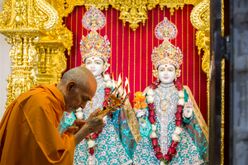
In addition to being focal points of religious activity, BAPS mandirs are also centres of culture.[125] Many forms of traditional Indian art have their roots in Hindu scriptures and have been preserved and flourished in the setting of mandirs.[126] Many BAPS mandirs outside of India hold Gujarati classes to facilitate scriptural study, instruction in traditional dance forms in preparation for performances in festival assemblies, and music classes where students are taught how to play traditional instruments such as tabla.[127][128] Devotees view the mandir as a place for transmission of knowledge of Hindu values and their incorporation into daily routines, family life, and careers.[8][web 1]
Apart from classes teaching about religion and culture, mandirs are also the site of activities focused on youth development. Many centres organize college preparatory classes, leadership training seminars and workplace skills development workshops.[129][130][131] Centres often host women's conferences aimed at empowering women.[132] They also host sports tournaments and initiatives to promote healthy lifestyles among children and youth.[133] Many centres also host parenting seminars, marriage counseling, and events for family bonding.[134][135]
BAPS mandirs and cultural centres serve as hubs of several humanitarian activities powered by local volunteers. Mandirs in the US and UK host an annual walkathon to raise funds for local charities such as hospitals or schools.[136][137][138] Centres also host annual health fairs where needy members of the community can undergo health screenings and consultations.[139] During weekend assemblies, physicians are periodically invited to speak on various aspects of preventative medicine and to raise awareness on common conditions.[140] In times of disaster, centres closest to the affected area become hubs for relief activity ranging from providing meals to reconstructing communities.[141][142]
Notable mandirs
The founder of BAPS, Shastriji Maharaj, built the first mandir in Bochasan, Gujarat, which led the organisation to be known as "Bochasanwasi" (of Bochasan).[143]
The organisation's second mandir was built in Sarangpur, which also hosts a seminary for BAPS swamis.[144]
The mandir in Gondal was constructed around the Akshar Deri, the cremation memorial of Gunatitanand Swami, who is revered as a manifestation of Aksharbrahman.[120]
Shastriji Maharaj constructed his last mandir on the banks of the River Ghela in Gadhada, where Swaminarayan resided for the majority of his adult life.[145][146]
Yogiji Maharaj constructed the mandir in the Shahibaug section of Ahmedabad, which remains the site of the international headquarters of the organisation.[147]
Under the leadership of Pramukh Swami Maharaj, over 25 additional shikharbaddha mandirs have been built across Gujarat and other regions of India and abroad.
As a consequence of the Indian emigration patterns, mandirs have been constructed in Africa, Europe, North America, and the Asia-Pacific region.[148] The BAPS mandir in Neasden, London was the first traditional Hindu mandir built in Europe.[149] The organisation has six shikharbaddha mandir's in North America in the metro areas of Houston, Chicago, Atlanta, Toronto, Los Angeles, and in the New Jersey suburb of Robbinsville Township, near Trenton, New Jersey.[150]
BAPS has constructed two large temple complexes dedicated to Swaminarayan called Swaminarayan Akshardham, in New Delhi and Gandhinagar, Gujarat, which in addition to a large stone-carved mandir has exhibitions that explain Hindu traditions and Swaminarayan history and values.[151]
BAPS is constructing a Hindu stone temple in the Middle East, in Abu Dhabi, the capital city of United Arab Emirates, on 55,000 square metres of land. Projected to be completed by 2021, and open to people of all religious backgrounds, the Indian Prime Minister Narendra Modi participated in the foundation stone-laying ceremony in the UAE, which is home to over three million people of Indian origin.[152]
BAPS Charities
BAPS Charities is a global non-religious, charitable organisation that originated from the Bochasanwasi Akshar Purushottam Swaminarayan Sanstha (BAPS) with a focus on serving society.[9] Their history of service activities can be traced back to Swaminarayan (1781-1830), who opened alms houses, built shelters, worked against addiction, and abolished the practice of sati and female infanticide with the goals of removing suffering and effecting positive social change.[153] This focus on service to society is stated in the organisation's vision, that "every individual deserves the right to a peaceful, dignified, and healthy way of life. And by improving the quality of life of the individual, we are bettering families, communities, our world, and our future."[9]
BAPS Charities aims to express a spirit of selfless service through Health Awareness, Educational Services, Humanitarian Relief, Environmental Protection & Preservation and Community Empowerment. From Walkathons or Sponsored Walks that raise funds for local communities to supporting humanitarian relief in times of urgent need or from community health fairs to sustaining hospitals and schools in developing countries, BAPS Charities provides an opportunity for individuals wishing to serve locally and globally.
Vegetarianism
BAPS advocates the principle of ahimsa (non-violence) and practices vegetarianism.[154][155] BAPS members are strict lacto-vegetarians that also do not consume onion and garlic as they are believed to have tamasic properties.[155][156] They only eat food cooked by their own members. To help with this BAPs have food courts serving vegetarian food at its mandirs.[155]
Notes
- ^ In many of his discourses in the Vachanamrut (Gadhada I-71,[14] Gadhada III-26[15] and Vadtal 5[16]) Swaminarayan explains that there forever exists a Gunatit Guru[12] (perfect devotee) through whom Swaminarayan manifests on earth[17] for the ultimate redemption of jivas.[18]
- ^ According to the BAPS, numerous historical accounts[20][21] and texts[22] written during Swaminarayan and Gunatitanand Swami's time period identify Gunatitanand Swami as the embodiment of Akshar.
- ^ Bhagatji Maharaj over time came to believe that the doctrine of Akshar-Purushottam Upasana was the true doctrine propagated by Swaminarayan.[web 2] Bhagatji Maharaj was Shastriji Maharaj's guru, and over time, Shastriji Maharaj also became a strong proponent of the Akshar-Purushottam Upasana.[4] After Bhagatji Maharaj died on 7 November 1897,[24] Shastriji Maharaj became the primary proponent of the doctrine of Akshar-Purushottam Upasana.[4]
- ^ Ekantik: "complete," "absolute";[web 4] Satpurush: "good or wise man."[web 5]
- ^ أ ب From 1822 to 1828, Swaminarayan constructed a total of six shikharbaddha mandirs in Gujarat to propagate his teachings; in each he installed the murtis of a principal deity coupled with their ideal devotee in the central shrine: Nar-Narayan-Dev in Ahmedabad (1822) and Bhuj (1823), Lakshmi-Narayan-Dev in Vadtal (1824), Madan-Mohan-Dev in Dholera (1826), Radha-Raman-Dev in Junagadh (1828), and Gopi-Nathji in Gadhada (1828).[39]
- ^ According to the BAPS, the fundamental beliefs of the BAPS date back to the time of Swaminarayan.[32] One revelation of Gunatitanand Swami as Akshar occurred in 1810 at the grand yagna of Dabhan, during which Swaminarayan initiated Gunatitanand Swami as a swami. On this occasion, Swaminarayan publicly confirmed that Gunatitanand Swami was the incarnation of Akshar, declaring, "Today, I am extremely happy to initiate Mulji Sharma. He is my divine abode – Akshardham, which is infinite and endless." The first Acharya of the Vadtal diocese, Raghuvirji Maharaj, recorded this declaration in his composition, the Harililakalpataru (7.17.49–50).[33] The Swaminarayan-Bhashyam is a published commentary written by Bhadreshdas Swami in 2007 that explicates the roots of Akshar-Purushottam Upasana in the Upanishads, the Bhagavad Gita, and the Brahma Sutras.[34][35] This is further corroborated in a classical Sanskrit treatise, also authored by Bhadreshdas Swami, called Swaminarayan-Siddhanta-Sudha.
- ^ Members of BAPS point to numerous historical anecdotes and scriptural references, particularly from the central Swaminarayan text known as the Vachanamrut, as veritable evidence that Gunatitanand Swami was the manifest form of Akshar.[91] Swaminarayan refers to this concept specifically in Vachnamrut Gadhada I-21, Gadhada I-71, Gadhada III-26, Vadtal 5.[92] Following Gunatitanand Swami, the lineage continued on through Bhagatji Maharaj (1829–1897), Shastriji Maharaj (1865–1951), Yogiji Maharaj (1892–1971), and Pramukh Swami Maharaj (1921–2016). Today Mahant Swami Maharaj is said to be the manifest form of Akshar.[76]
- ^ For example, in Vachanamrut Gadhada I-37, Swaminarayan states: "In fact, the darshan of such a true Bhakta of God is equivalent to the darshan of God Himself"[94] Moreover, in Vachanamrut Vadtal 5, Swaminarayan states: "Just as one performs the mãnsi puja of God, if one also performs the mãnsi puja of the ideal Bhakta along with God, by offering him the prasãd of God; and just as one prepares a thãl for God, similarly, if one also prepares a thãl for God's ideal Bhakta and serves it to him; and just as one donates five rupees to God, similarly, if one also donates money to the great Sant – then by performing with extreme affection such similar service of God and the Sant who possesses the highest qualities...he will become a devotee of the highest calibre in this very life."[95]
- ^ This practice is mentioned by Swaminarayan in Vachanamrut Vadtal 5: "by performing with extreme affection such similar service of God and the Sant who possesses the highest qualities, even if he is a devotee of the lowest type and was destined to become a devotee of the highest type after two lives, or after four lives, or after ten lives, or after 100 lives, he will become a devotee of the highest caliber in this very life. Such are the fruits of the similar service of God and God's Bhakta."[98]
References
- ^ Mamtora 2021.
- ^ A.Patel 2018.
- ^ Gadhia 2016, p. 157.
- ^ أ ب ت ث ج Williams 2001, p. 55.
- ^ أ ب Rinehart 2004, p. 215.
- ^ أ ب James 2017.
- ^ أ ب ت ث NN 2019, p. 51.
- ^ أ ب Kim 2001, p. 418–422.
- ^ أ ب ت Clarke 2011, pp. 40–49.
- ^ أ ب Kim 2001, p. 317.
- ^ Kim 2005.
- ^ أ ب ت Kim 2009, p. 363.
- ^ Paranjape 2005, p. 117, 129.
- ^ Swaminarayan 2006, p. 147–148.
- ^ Swaminarayan 2006, p. 630–631.
- ^ Swaminarayan 2006, p. 534.
- ^ Williams 1984, p. 92.
- ^ Dave 1974, p. 178.
- ^ أ ب ت Dave 1974, p. 186.
- ^ Dave 1974, p. 89.
- ^ Acharya, Viharilalji Maharaj (1911). Shri Kirtan Kaustubhmala (1st ed.). Published by Kothari Hathibhai Nanjibhai by the order of Acharya Shripatiprasadji Maharaj and Kothari Gordhanbhai. p. 13.
- ^ Raghuvirji Maharaj, Acharya (1966). Shri Harililakalpataru (1st ed.). Translated by Sadhu Shwetvaikunthdas. Mumbai: Sheth Maneklal Chunilal Nanavati Publishers.
- ^ Paranjape 2005, p. 117.
- ^ Ishwarcharandas, Sadhu (1978). Pragji Bhakta – A short biography of Brahmaswarup Bhagatji Maharaj. Ahmedabad: Swaminarayan Aksharpith. p. 65.
- ^ Kim 2001, p. 327, 358.
- ^ Williams, Raymond Brady (2008). Encyclopedia of new religious movements Swaminarayan Hinduism Founder: Sahajanand Swami Country of origin: India (1. publ. ed.). London: Routledge. ISBN 978-0-415-45383-7.
- ^ أ ب ت Kim 2009, p. 364.
- ^ Williams 1984, p. 55.
- ^ Williams 2018, p. 61.
- ^ Kim 2009, p. 364-365.
- ^ Williams 2018, p. 93.
- ^ Amrutvijaydas, Sadhu (2006). Shastriji Maharaj Life and Work. Amdavad: Swaminarayan Aksharpith.ISBN 81-7526-305-9.
- ^ Acharya, Raghuvirji Maharaj; Sadhu Shwetvaikunthdas (Translator) (1966). Shri Harililakalpataru (1st ed.). Mumbai: Sheth Maneklal Chunilal Nanavati Publishers.
- ^ Amrutvijaydas, Sadhu; Williams, Raymond Brady; Paramtattvadas, Sadhu (2016-04-01). Swaminarayan and British Contacts in Gujarat in the 1820s (in الإنجليزية الأمريكية). Oxford University Press. doi:10.1093/acprof:oso/9780199463749.003.0005. ISBN 9780199086573.
- ^ Bhadreshdas, Sadhu (April–June 2014). "Guru's grace empowers philosophical treatise". Hinduism Today.
- ^ Kim 2009, p. 363–365.
- ^ Williams 2001, pp. 54–56.
- ^ أ ب ت ث ج ح خ د ذ ر ز س ش ص ض Amrutvijaydas, Sadhu (2007). 100 Years of BAPS. Amdavad: Aksharpith. ISBN 978-81-7526-377-2.
- ^ Kim 2009, p. 364–365.
- ^ Kim 2001, p. 91.
- ^ أ ب Kim 2009, p. 365.
- ^ Dave 1974, p. 183.
- ^ Shelat, Kirit (2005). Yug Purush Pujya Pramukh Swami Maharaj – a life dedicated to others. Ahmedabad: Shri Bhagwati Trust. p. 7.
- ^ أ ب ت ث ج Shelat, Kirit (2005). Yug Purush Pujya Pramukh Swami Maharaj – a life dedicated to others. Ahmedabad: Shri Bhagwati Trust. p. 8.
- ^ Vivekjivandas, Sadhu (June 2000). "Pramukh Varni Din". Swaminarayan Bliss.
- ^ "Pramukh Varni Din". Swaminarayan. Swaminarayan Aksharpith. Retrieved 4 August 2013.
- ^ Dave, Kishore M. (2009). Shastriji Maharaj – A brief biography of Brahmaswarup Shastriji Maharaj. Ahmedabad: Swaminarayan Aksharpith. p. 111. ISBN 978-81-7526-129-7.
- ^ Williams 2001, p. 60.
- ^ أ ب ت ث ج Brear, Douglas (1996). "Transmission of sacred scripture in the British East Midlands: the Vachanamritam". In Raymond Brady Williams (ed.). A sacred thread: modern transmission of Hindu traditions in India and abroad (Columbia University Press ed.). New York: Columbia University Press. ISBN 0-231-10779-X.
- ^ "Yogiji Maharaj – Sermons of Yogiji Maharaj". Swaminarayan. Swaminarayan Aksharpith. Retrieved 4 August 2013.
- ^ Dave 1974, p. 187.
- ^ أ ب Brahmbhatt, Arun (2014). Global Religious Movements Across Borders: Sacred Service. Oxon: Ashgate Publishing. ISBN 978-1-409-45687-2.
- ^ أ ب Younger, Paul (2010). New homelands: Hindu communities in Mauritius, Guyana, Trinidad, South Africa, Fiji, and East Africa ([Online-Ausg.] ed.). Oxford: Oxford University Press. p. 266. ISBN 978-0-19-539164-0.
- ^ Salvadori, Cynthia (1989). "Revivals, reformations & revisions of Hinduism; the Swaminarayan religion". Through Open Doors: A View of Asian Cultures in Kenya: 127.
- ^ أ ب Salvadori, Cynthia (1989). "Revivals, reformations & revisions of Hinduism; the Swaminarayan religion". Through Open Doors: A View of Asian Cultures in Kenya: 128.
- ^ أ ب ت ث ج ح Shelat, Kirit (2005). Yug Purush Pujya Pramukh Swami Maharaj – a life dedicated to others. Ahmedabad: Shri Bhagwati Trust. p. 17.
- ^ Dave 1974, p. 189.
- ^ Heath, Deana; Mathur, Chandana, eds. (2010). Communalism and globalization in South Asia and its diaspora. Abingdon, Oxon: Routledge. p. 52. ISBN 978-0-203-83705-4.
- ^ أ ب ت ث ج Kurien, Prema A. (2007). A place at the multicultural table: the development of an American Hinduism ([Online-Ausg.]. ed.). New Brunswick, NJ [u.a.]: Rutgers Univ. Press. p. 105. ISBN 978-0-8135-4056-6.
- ^ Jones, Constance A.; Ryan, James D. (2008). Encyclopedia of Hinduism. New York: Checkmark Books. p. 431. ISBN 978-0-8160-7336-8.
- ^ Kurien, Prema A. (2007). A place at the multicultural table: the development of an American Hinduism (online ed.). New Brunswick, New Jersey: Rutgers University Press. p. 106. ISBN 978-0-8135-4056-6.
- ^ Kim 2001, p. 77.
- ^ أ ب Jones, Lindsay (2005). Encyclopedia of religion. Detroit: Macmillan Reference USA/Thomson Gale, c2005. p. 8891. ISBN 978-0028659824.
- ^ "Bhagwan Swaminarayan's Spiritual Lineage". BAPS Swaminarayan Sanstha. Retrieved 2016-08-29.
- ^ Williams 2001.
- ^ Sadhu, Amrutvijaydas (December 2007). 100 Years of BAPS. Amdavad: Swaminarayan Aksharpith. p. 169. ISBN 978-8175263772.
- ^ Staff, India West. "BAPS Inaugurates Stone Mandir in New Jersey". India West (in الإنجليزية). Retrieved 2020-05-26.
- ^ "Pramukh Swami's Vicharan". BAPS Swaminarayan Sanstha. Retrieved 2016-08-29.
- ^ أ ب Kim, Hanna Hea-Sun (2012). "A Fine Balance: Adaptation and Accommodation in the Swaminarayan Sanstha". Gujarati Communities Across the Globe: Memory, Identity and Continuity. Edited by Sharmina Mawani and Anjoom Mukadam. Stoke-on-Trent, United Kingdom: Trentham Books: 141–156. doi:10.1111/rsr.12043_9.[مطلوب توضيح]
- [[#cite_ref-FOOTNOTEWilliams2001[[تصنيف:مقالات_بالمعرفة_بحاجة_لذكر_رقم_الصفحة_بالمصدر_from_June_2021]][[Category:Articles_with_invalid_date_parameter_in_template]]<sup_class="noprint_Inline-Template_"_style="white-space:nowrap;">[<i>[[المعرفة:Citing_sources|<span_title="هذه_المقولة_تحتاج_مرجع_إلى_صفحة_محددة_أو_نطاق_من_الصفحات_تظهر_فيه_المقولة'"`UNIQ--nowiki-00000098-QINU`"'_(June_2021)">صفحة مطلوبة</span>]]</i>]</sup>_81-0|^]] Williams 2001, p. [صفحة مطلوبة].
- [[#cite_ref-FOOTNOTEWilliams2001[[تصنيف:مقالات_بالمعرفة_بحاجة_لذكر_رقم_الصفحة_بالمصدر_from_June_2021]][[Category:Articles_with_invalid_date_parameter_in_template]]<sup_class="noprint_Inline-Template_"_style="white-space:nowrap;">[<i>[[المعرفة:Citing_sources|<span_title="هذه_المقولة_تحتاج_مرجع_إلى_صفحة_محددة_أو_نطاق_من_الصفحات_تظهر_فيه_المقولة'"`UNIQ--nowiki-0000009A-QINU`"'_(June_2021)">صفحة مطلوبة</span>]]</i>]</sup>_82-0|^]] Williams 2001, p. [صفحة مطلوبة].
- [[#cite_ref-FOOTNOTEWilliams2001[[تصنيف:مقالات_بالمعرفة_بحاجة_لذكر_رقم_الصفحة_بالمصدر_from_June_2021]][[Category:Articles_with_invalid_date_parameter_in_template]]<sup_class="noprint_Inline-Template_"_style="white-space:nowrap;">[<i>[[المعرفة:Citing_sources|<span_title="هذه_المقولة_تحتاج_مرجع_إلى_صفحة_محددة_أو_نطاق_من_الصفحات_تظهر_فيه_المقولة'"`UNIQ--nowiki-0000009C-QINU`"'_(June_2021)">صفحة مطلوبة</span>]]</i>]</sup>_83-0|^]] Williams 2001, p. [صفحة مطلوبة].
- ^ أ ب ت "Pramukh Swami's Work". BAPS Swaminarayan Sanstha. Retrieved 2016-08-29.
- ^ Rudert, Angela Carol (May 2004). Inherent Faith and Negotiated Power: Swaminarayan Women in the United States (MA thesis) (in الإنجليزية الأمريكية). Cornell University. hdl:1813/106.
- ^ "700 BAPS Sadhus". BAPS Swaminarayan Sanstha. Retrieved 2016-08-29.
- ^ أ ب ت "Final Darshan and Rites of Pramukh Swami Maharaj". BAPS Swaminarayan Sanstha. Retrieved 2016-08-13.
- ^ Kulkarni, Deepali (December 2018). "Digital Mūrtis, Virtual Darśan and a Hindu Religioscape". Nidān: International Journal for Indian Studies. 3 (2): 40–54.
- ^ Mangalnidhidas, Sadhu (2019). Sacred Architecture and Experience BAPS Shri Swaminarayan Mandir, Robbinsville, New Jersey. Ahmedabad, Gujarat, India: Swaminarayan Aksharpith. p. 100. ISBN 978-19-4746-101-7.
- ^ Writer, Staff. "BAPS Temple holds installation of 1st pillar, Mandapam, and Visarjan in New Jersey | News India Times" (in الإنجليزية الأمريكية). Retrieved 2019-12-21.
- ^ "Everything we know about the UAE's first traditional Hindu temple". The National (in الإنجليزية). Retrieved 2019-12-21.
- ^ "Guruhari Ashirwad - YouTube". YouTube (in الإنجليزية). Retrieved 2019-12-21.
- ^ Correal, Annie (2021-05-11). "Hindu Sect Is Accused of Using Forced Labor to Build N.J. Temple". The New York Times (in الإنجليزية الأمريكية). ISSN 0362-4331. Retrieved 2021-05-12.
- ^ Choi, Joseph (2021-05-11). "Federal agents probe Hindu sect for using forced labor to build New Jersey temple". TheHill (in الإنجليزية). Retrieved 2021-05-12.
- ^ Correal, Annie (10 November 2021). "Hindu Sect Accused of Using Forced Labor at More Temples Across U.S." The New York Times.
- ^ أ ب Williams 1984, p. 73.
- ^ Gadhada I-21 The Vachanamrut: Spiritual Discourses of Bhagwan Swaminarayan. Ahmedabad: Swaminarayan Aksharpith. 2003. 2nd edition. ISBN 81-7526-190-0, pg. 31.
- ^ أ ب Paramtattvadas, Swami (2017). An Introduction to Swaminarayan Hindu Theology. Cambridge University Press. ISBN 9781316611272.
- ^ أ ب Williams, Raymond Brady (2004). "The Holy Man as the Abode of God in Swaminarayan Hinduism". Williams on South Asian Religions and Immigration; Collected Works (Ashgate Publishing, Ltd.)
- ^ Williams 2001, p. 55, 92.
- ^ Kim 2001, p. 65.
- ^ Kim 2001, p. 76.
- ^ Williams 2001, p. 92.
- ^ Kim 2001, p. 453–455.
- ^ Vachanamrut, Gadhada I-37, The Vachanamrut: Spiritual Discourses of Bhagwan Swaminarayan. Ahmedabad: Swaminarayan Aksharpith. 2003. 2nd edition. ISBN 81-7526-190-0, p. 65
- ^ Vartal 5. The Vachanamrut: Spiritual Discourses of Bhagwan Swaminarayan. Ahmedabad: Swaminarayan Aksharpith. 2003. 2nd edition. p. 536–537. ISBN 81-7526-190-0
- ^ Williams 2001, p. 86.
- ^ Williams 1984, p. 112.
- ^ Vachanamrut, Vartal 5, The Vachanamrut: Spiritual Discourses of Bhagwan Swaminarayan. Ahmedabad: Swaminarayan Aksharpith. 2003. 2nd edition, p.534
- ^ Kim 2001, p. 291.
- ^ Shikshapatri, shloka 116.
- ^ Kim 2001, p. 295, 325.
- ^ G. Sundaram. The Concept of Social Service in the Philosophy of Sri Swaminarayan. p. 45
- ^ Kim 2001, p. 319–320.
- ^ Mukundcharandas, Sadhu (2004). Vachnamrut Handbook (Insights into Bhagwan Swaminarayan's Teachings). Amdavad: Swaminarayan Aksharpith. ISBN 81-7526-263-X p. 160
- ^ G. Sundaram. The Concept of Social Service in the Philosophy of Sri Swaminarayan. p. 43
- ^ Kim 2001, p. 358.
- ^ أ ب ت "FAQ-Related to BAPS Swaminaryan Sansthã-General".
- ^ Kim 2001, p. 456.
- ^ Kim 2001, p. 333.
- ^ Kim 2001, p. 326.
- ^ Kim 2001, p. 343.
- ^ Kim 2001, p. 319–320, 389.
- ^ Kim 2001, p. 389.
- ^ Gadhada II-27 (2001). The Vachanamrut: Spiritual Discourses of Bhagwan Swaminarayan. Amdavad: Swaminarayan Aksharpith. ISBN 81-7526-190-0.
{{cite book}}: CS1 maint: numeric names: authors list (link) - ^ Kim 2009, p. 7–13.
- ^ Williams 2001, p. 240.
- ^ Williams 2001, pp. 131, 140.
- ^ Jones, Constance (2007). Encyclopedia of Hinduism. New York: Infobase Publishing. p. 119. ISBN 978-0-8160-7336-8.
- ^ Williams 2001, p. 140.
- ^ أ ب Williams 2001, p. 132.
- ^ Williams 2001, p. 50.
- ^ Williams 2001, p. 62.
- ^ Williams 2001, pp. 138–147.
- ^ Mukundcharandas, Sadhu. (2007). Hindu rites & rituals: sentiments, sacraments & symbols. Das, Jnaneshwar., Swaminarayan Aksharpith. (1st ed.). Amdavad, India: Swaminarayan Aksharpith. ISBN 978-8175263567. OCLC 464166168.
- ^ Kim 2009, p. 21.
- ^ Williams 2001, p. 220.
- ^ "Shri Swaminarayan Mandir". Pluralism Project. Harvard University. Retrieved 11 January 2013.
- ^ "BAPS celebrates Swaminarayan Jayanti & Ram Navmi". India Post. 22 April 2011. Retrieved 11 January 2013.
- ^ Dave, Hiral (20 February 2009). "Baps tells Youth to uphold values". Daily News & Analysis. Retrieved 11 January 2013.
- ^ "Strive to be unique, Kalam tells youth". India Post. 29 April 2011. Retrieved 11 January 2013.
- ^ Patel, Divyesh. "BAPS Commemorates Education with Educational Development Day". ChinoHills.com. Archived from the original on 22 February 2013. Retrieved 11 January 2013.
- ^ Padmanabhan, R. "BAPS Swaminarayan Sanstha Hosts Women's Conference in Chicago". NRI Today. Archived from the original on 16 September 2013. Retrieved 11 January 2013.
- ^ Piccirilli, Amanda (13 August 2012). "BAPS Charities stresses importance of children's health". The Times Herald. Retrieved 11 January 2013.
- ^ "Parents Are the Key". Hinduism Today. Retrieved 11 January 2013.
- ^ "BAPS Charities". Georgetown University. Archived from the original on 10 March 2014. Retrieved 11 January 2013.
- ^ Rajda, K (29 June 2012). "Local communities join BAPS Walkathon". IndiaPost. Retrieved 11 January 2013.
- ^ "BAPS Charities Hosts 15th Annual Walkathon". India West. 6 June 2012. Archived from the original on 8 June 2012. Retrieved 11 January 2013.
- ^ "BAPS Charities Host Community Walk in Support of American Diabetes Association and Stafford MSD Education Fund". Indo American News. Retrieved 11 January 2013.[dead link]
- ^ Gibson, Michael. "BAPS Charities Health Fair 2012". NBCUniversal. Retrieved 11 January 2013.
- ^ Patel, Divyesh. "BAPS Charities to Hold Women's FREE Health Awareness Lectures 2010 on Saturday, June 5th 2010". ChinoHills.com. Archived from the original on 28 July 2013. Retrieved 11 January 2013.
- ^ "BAPS Care International launches relief efforts for Hurricane Katrina victims". India Herald. Retrieved 11 January 2013.
- ^ "BAPS Charities helps victims of tornadoes". IndiaPost. 20 May 2011. Retrieved 11 January 2013.
- ^ Kim 2009, p. 8–9.
- ^ Williams 2001, p. 112.
- ^ Williams 2001, p. 19.
- ^ Kim 2009, p. 9.
- ^ Kim 2001, p. 86.
- ^ Kim 2009, p. 13–14.
- ^ Kim 2009, p. 11–12.
- ^ "Traditional Hindu temple opening in Robbinsville, part of BAPS community". 29 July 2014.
- ^ Kim, Hanna (2007). Gujaratis in the West: Evolving Identities in Contemporary Society, Ch. 4: Edifice Complex: Swaminarayan Bodies and Buildings in the Diaspora. Newcastle, UK: Cambridge Scholars Publishing. pp. 67–70. ISBN 978-1-84718-368-2.
- ^ "PM Modi officially launches foundation stone-laying ceremony for first Hindu temple in Abu Dhabi – Times of India ►". The Times of India. Retrieved 2018-02-11.
- ^ Clarke 2011, pp. 40–49; Paranjape 2005, p. 119.
- ^ Clarke, Matthew. (2011). Development and Religion: Theology and Practice. Edward Elgar. p. 42. ISBN 978-0857930736
- ^ أ ب ت "Vegetarianism". baps.org. Retrieved 27 March 2023.
- ^ "Vegetarian Diet". baps.org. Retrieved 27 March 2023.
Sources
- Printed sources
- Clarke, Matthew (2011). Development and Religion: Theology and Practice. Northampton, Massachusetts: Edward Elgar Publishing. pp. 40–49. ISBN 9781848445840.
- Dave, H.T (1974). Life and Philosophy of Shree Swaminarayan 1781–1830. London: George Allen & Unwin. ISBN 0-04-294082-6.
- Gadhia, Smit (2016), Akshara and Its Four Forms in Swaminarayan's Doctrine, Oxford University Press, pp. 156–171, doi:, ISBN 978-0-19-946374-9
- James, Jonathan D. (2017). Transnational religious movements: faith's flows. Thousand Oaks. ISBN 9789386446565. OCLC 1002848637.
{{cite book}}: CS1 maint: location missing publisher (link) - Kim, Hanna (2001). Being Swarninarayan: the ontology and significance of belief in the construction of a Gujarati diaspora. Ann Arbor: Bell & Howell Information and Learning Company.
- Kim, Hanna H. (2005), "Swaminarayan Movement", in Jones, Lindsay, Encyclopedia of Religion: 15-Volume Set, 13 (2nd ed.), Detroit, Mi: MacMillan Reference USA, ISBN 0-02-865735-7, https://www.encyclopedia.com/environment/encyclopedias-almanacs-transcripts-and-maps/swaminarayan-movement
- Kim, Hanna (December 2009). "Public engagement and personal desires: BAPS Swaminarayan temples and their contribution to the discourses on religion". International Journal of Hindu Studies. 13 (3): 357–390. doi:10.1007/s11407-010-9081-4.-->
- Mamtora, Bhakti (2021). "BAPS: Pramukh Swami". In Jacobsen, Knut A.; Basu, Helene; Malinar, Angelika; Narayanan, Vasudha (eds.). Brill's Encyclopedia of Hinduism Online. Retrieved 5 February 2020.
- NN (October–December 2019). "BAPS Swaminarayan Sanstha Today". Hinduism Today. Himalayan Academy. Retrieved 2019-11-22.
- Paranjape (2005). Dharma and development: the future of survival. New Delhi: Samvad India Foundation. p. 117. ISBN 81-901318-3-4.
- A.Patel, Aarti (2018). "Secular Conflict". Nidān: International Journal for Indian Studies. 3 (2): 55–72.
- Swaminarayan (2006). The Vachanamrut – Spiritual Discourses of Bhagwan Swaminarayan (An English Translation). Amdavad: Aksharpith. ISBN 81-7526-320-2.
- Williams, Raymond Brady (1984). A New Face of Hinduism. Cambridge [Cambridgeshire]: Cambridge University Press. ISBN 0-521-27473-7.
- Williams, Raymond (2001). An Introduction to Swaminarayan Hinduism. New York: Cambridge University Press. ISBN 0-521-65279-0.
- Williams, Raymond Brady (2018). An introduction to Swaminarayan Hinduism (Third ed.). Cambridge, United Kingdom: Cambridge University Press. ISBN 978-1-108-42114-0. OCLC 1038043717.
- Rinehart, Robin (2004). Contemporary Hinduism: Ritual, Culture, and Practice. Library of Congress. ISBN 1-57607-905-8.
- Web-sources
- ^ أ ب "1,200 young adults from North America attend Spiritual Quotient Seminar". India Herald. 30 June 2010. Retrieved 11 January 2013.
- ^ "Bhagatji Maharaj's Life-Realisation".
- ^ BAPS Swaminarayan Sanstha, Bhagatji: The Greatest Ekantik Saint
- ^ Sanskrit Dictionary for Spoken Sanskrit, ekantik
- ^ Sanskrit Dictionary for Spoken Sanskrit, satpurush
External links
- CS1 الإنجليزية الأمريكية-language sources (en-us)
- جميع الصفحات التي تحتاج تنظيف
- مقالات بالمعرفة تحتاج توضيح from June 2021
- مقالات بالمعرفة بحاجة لذكر رقم الصفحة بالمصدر from June 2021
- CS1 maint: numeric names: authors list
- Articles with dead external links from July 2017
- Short description is different from Wikidata
- Articles with hatnote templates targeting a nonexistent page
- Missing redirects
- Pages using multiple image with auto scaled images
- CS1 maint: location missing publisher
- Swaminarayan Sampradaya
- Hindu denominations
- Hindu organisations based in India
- International Hindu organizations
- Religious organizations established in 1907
- Religions that require vegetarianism
- 1907 establishments in British India
